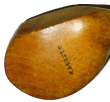
|
Registration Edit profile catalogue auction shopping cart shipping history makers search faq news links about contact |

Scottish Golf History
ClubsScare Neck Woods(Source: © 2003 - 2014, Douglas MacKenzie) If you set out to make your own wooden golf club today, it would probably involve drilling a hole in a clubhead for a shaft to go in. Firstly, most people working with wood have an electric drill to work with and, secondly, you go with what is familiar. The same was the case for the eighteenth century clubmakers in the fishing villages of eastern Scotland. They would be using hand tools, principally planes, saws and chisels and would look at the commonest way of joining two pieces of wood. Since Roman times masts and spars on boats and ships were joined using a "scarffed" joint where either side of the pieced of wood to be joined were cut and planed to an angle of 45 degrees and glued together. As clubmakers became distinct from shipwrights and joiners, the term became modified to "scared" and, in categorising clubs, we talk of scared (or spliced) head clubs to distinguish them from the more modern socket head.
The method remained essentially the same for 150 years or so and J H Taylor described the method in '.... our next business is with the shaft. Place it on the bench with its face against something to prevent its slipping, and taper it from top to bottom by planing the four sides equally. When it has been reduced to about half an inch square at the bottom end, round it up keeping it as straight as possible. Before cutting the scare you must find out which way the grain runs, for the shaft will be made stronger or weaker by the manner in which it is glued to the head. Take a chisel and slice off one end, and you will see that the grain runs either straight across or up and down, just as you hold the shaft. If it were glued on with the grain running up and down, it would not be so strong by any means as if it ran through from side to side. Due regard having been paid to this, put the thin end of your shaft into the vice and cut the scare with the chisel, standing close to the shaft on the right of the vice. The scare should be about six inches long, and should be made very thin at the end. After you have cut it off roughly with the chisel, take the plane and make it smooth, keeping it, if possible, a little hollow in the middle, and then rough the surface with the cabinet rasp so that the glue may get a firm hold. Plane the scare of the head smooth, taking as little off it as possible at first, and tie it to the shaft to see how it lies. If this is made too upright it cannot often be made flat again. To make it more upright the scare must be planed off at the end farthest from the angle.Sometimes the scare was the other way around, the so-called reverse scare, Cuthbert Butchart made some clubs in this way. W L Purves patented a “side-on” scare, with the join at right angles to the line of impact in 1905. I have not seen any of these which is hardly surprising. If they were made the structural mechanics sound far from sensible. There were some examples of socket head woods in the 19th century (and the first metal woods ca. 1893 used that method) but it was really the turn of twentieth century when significant quantities of socket head were first produced. Traditionalists grumbled that the new clubs did not feel right and that too much torsion was generated at the join. Socket-head advocates pointed to the robustness of the new design leading to less broken clubs. Neither argument had much merit. Both Vardon and Hagen won Open Championships well into the twentieth century using scared-head clubs and small volume craftsmen-producers of clubs, like Tom Auchterlonie, were still producing scared-heads for general play throughout the 1920s. Ultimately the argument was economic. The socket head was far better suited to power machinery and mass-production removing all the fiddly hand labour associated with making and joining the scare. |
|
site design dmc ltd | © 2000-2024 Antique Golf Clubs from Scotland

